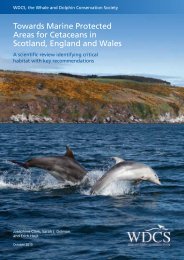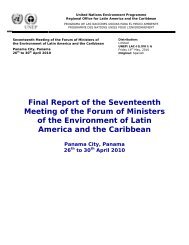Sea Turtle Recovery Action Plan for Barbados - WIDECAST
Sea Turtle Recovery Action Plan for Barbados - WIDECAST
Sea Turtle Recovery Action Plan for Barbados - WIDECAST
You also want an ePaper? Increase the reach of your titles
YUMPU automatically turns print PDFs into web optimized ePapers that Google loves.
CEP Technical Report No. 12<br />
As an alternative to the use of impermeable structures, the CCPU has been carrying out<br />
the re-vegetation (primarily using native "sea grape", Coccoloba uvifera) of selected beaches.<br />
The use of vegetation such as sea grape <strong>for</strong> beach stabilization will have an additional benefit <strong>for</strong><br />
nesting hawksbills, since they often prefer to nest amidst vegetation (Mortimer, 1982). Adequate<br />
protection of supralittoral vegetation cover on beaches may require additional legislation (section<br />
4.23). Another alternative which has been used to promote the accretion of beach sand is<br />
synthetic seaweed. Synthetic seaweed was installed at Rockley Beach on the south coast on an<br />
experimental basis in 1985. After some initial success and noticeable sand build up, the seaweed<br />
fronds started to sink under the weight of enmeshed sand and beach erosion resumed. There are<br />
no immediate plans to install any more synthetic seaweed in <strong>Barbados</strong> unless the weighting<br />
problem is resolved.<br />
The reconstruction of beaches elsewhere in the region is sometimes accomplished by<br />
dumping sand dredged from offshore onto a beach or <strong>for</strong>mer beach. This causes several<br />
problems <strong>for</strong> sea turtles, aside from the danger that heavy equipment on the beach and/or in<br />
adjacent waters can obstruct or preclude nesting and the new over-burden can smother<br />
incubating eggs. The most serious concern is that physical and organic characteristics of<br />
offshore sediments generally lead to compaction on the beach. This is well documented in<br />
Florida (USA) and was recently observed in Belize when a "renourishment" ef<strong>for</strong>t on Caye<br />
Chapel resulted in a hard compacted sand beach unusable to sea turtles <strong>for</strong> nesting (Smith et al.,<br />
1992). If this expensive method of reconstruction occurs in <strong>Barbados</strong>, the new sand should<br />
reflect the original material (e.g., organic content, grain size) and rebuilding should not occur<br />
during the nesting season.<br />
4.14 Prevent or mitigate degradation of marine habitat<br />
4.141 Dynamiting reefs<br />
Dynamiting <strong>for</strong> fish is illegal (section 4.21), but occurs quite regularly on both fringing<br />
and bank reefs on the west, south and southeast coasts. Dynamiting is an extremely destructive<br />
<strong>for</strong>m of fishing. Many fish killed by dynamiting do not float to the surface and there<strong>for</strong>e are not<br />
collected. Moreover, the destruction wrought on slow-growing coral reef environments reduces<br />
the fish carrying capacity of the system. Localized reef blasting has been conducted to improve<br />
fishing boat navigation channels at several points along the east coast (Tent Bay, Foul Bay,<br />
Skeete's Bay and Conset Bay). The long term effects of these actions are not fully known, but it<br />
appears that the exposed coral and coral rubble created by the blast are very susceptible to<br />
erosion, the navigation channels are already quite undercut, and the beaches parallel to reef cut<br />
channels may be more prone to erosion.<br />
Because healthy coral reef ecosystems are vital to sustainable fisheries and tourism (both<br />
economically important industries in <strong>Barbados</strong>), as well as to endangered sea turtles, it is the<br />
recommendation of this <strong>Recovery</strong> <strong>Action</strong> <strong>Plan</strong> that laws prohibiting the use of explosives <strong>for</strong> the<br />
purpose of fish extraction be rigorously en<strong>for</strong>ced. In addition, blasting to improve access <strong>for</strong><br />
marine vessels should be closely regulated, if not prohibited, and ongoing studies to evaluate the<br />
long-term effects of past blasting should be conducted. Penalties <strong>for</strong> fishing with explosives<br />
should be severe and include heavy fines, in addition to the confiscation of vessels and other<br />
equipment in use at the time of violation.<br />
Page 18

















